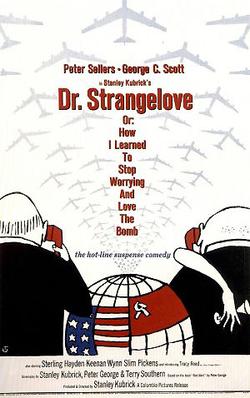
Dr. Strangelove or How I Learned to Love the Bomb
Ah, let me break down Stanley Kubrick’s darkly hilarious Cold War satire where everyone’s trying their best to avoid nuclear annihilation… and somehow making everything worse!
The film kicks off when General Jack D. Ripper, a man whose grip on reality is about as firm as his grip on proper bodily fluid management, decides to launch a nuclear attack on the USSR. His reasoning? He’s convinced the Soviets are corrupting America’s “precious bodily fluids” through fluoridation. (This is what happens when you get your medical information from questionable sources.)
Group Captain Lionel Mandrake, a British RAF officer, finds himself trapped at the base with the paranoid Ripper, trying desperately to get the recall code. Meanwhile, President Merkin Muffley (Peter Sellers in one of his three roles) assembles his advisors in the War Room, including the enthusiastically hawkish General Buck Turgidson, who treats potential nuclear war like an exciting football game.
Enter Dr. Strangelove himself (Sellers again), a wheelchair-bound ex-Nazi scientist whose right arm occasionally decides to recreate the Nazi salute (talk about muscle memory issues). He’s supposedly the expert, though his expertise seems mainly focused on underground bunkers and their potential for repopulating the Earth – with a special emphasis on the male-to-female ratio that would be “necessary.”
The situation gets even more complicated when we learn about the Soviet “Doomsday Machine” – a device designed to automatically trigger world-ending nuclear destruction if the USSR is attacked. The Soviets built it as a deterrent but hadn’t announced it yet because, as the Soviet Ambassador explains, they were saving it for a special occasion. (Because nothing says “surprise party” like mutually assured destruction.)
As bombers approach their targets, Major T.J. “King” Kong (Slim Pickens) leads his crew with cowboy enthusiasm, determined to complete their mission despite increasingly obvious signs that maybe they shouldn’t. This culminates in the iconic scene of Kong riding a nuclear bomb like a rodeo bull, which probably wasn’t in the Air Force training manual.
The film ends with a montage of nuclear explosions set to the cheery “We’ll Meet Again,” because sometimes gallows humor is the only appropriate response to the potential end of civilization.
Through it all, the film serves as a brilliant satire of Cold War politics, military bureaucracy, and the absurdity of nuclear deterrence – reminding us that sometimes the biggest threat to humanity isn’t our weapons, but the people in charge of them who insist they know exactly what they’re doing. It also suggests that maybe, just maybe, putting world-ending weapons in the hands of people worried about their precious bodily fluids isn’t the best idea.
The whole thing makes you wonder if somewhere, in some war room, there’s still a General Turgidson explaining how we can “win” a nuclear war with only 10-20 million casualties, “tops.”
4/5 ICMBs. I love Peter Seller’s comedy and him playing three roles in this movie probably set the standard for Eddie Murphy to follow in the 80’s. The comedy is absurdist and really reflects the time the movie was made and released. I’m not sure it would be very successful outside of that time however as the brand of humor is pretty specific. Overall though, superbly acted throughout even if it went a bit long in spots.